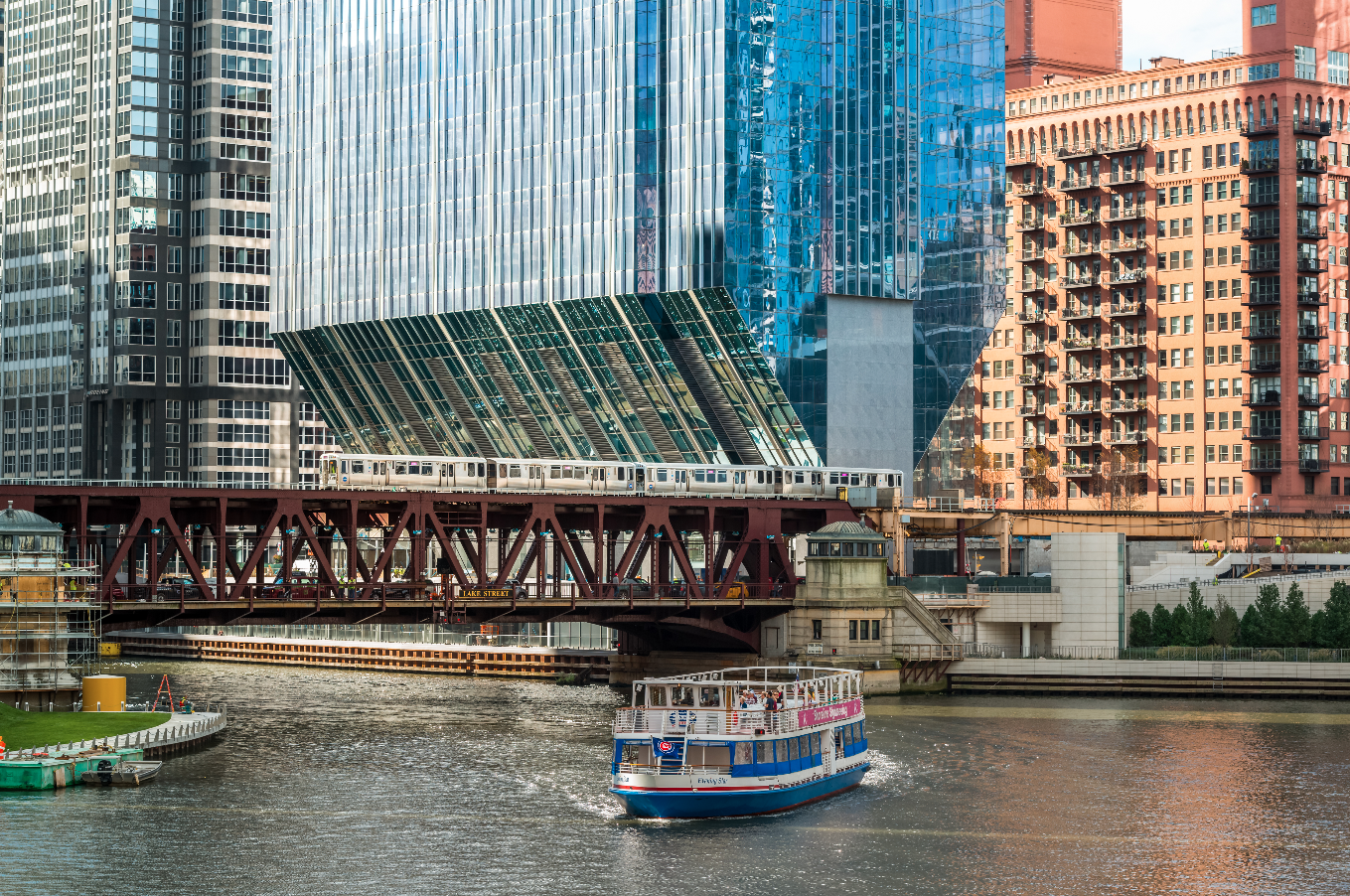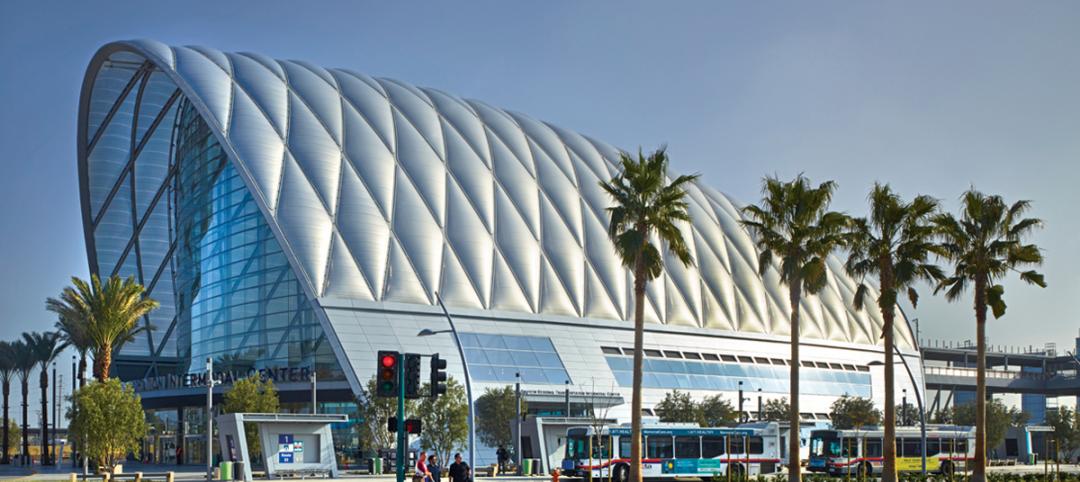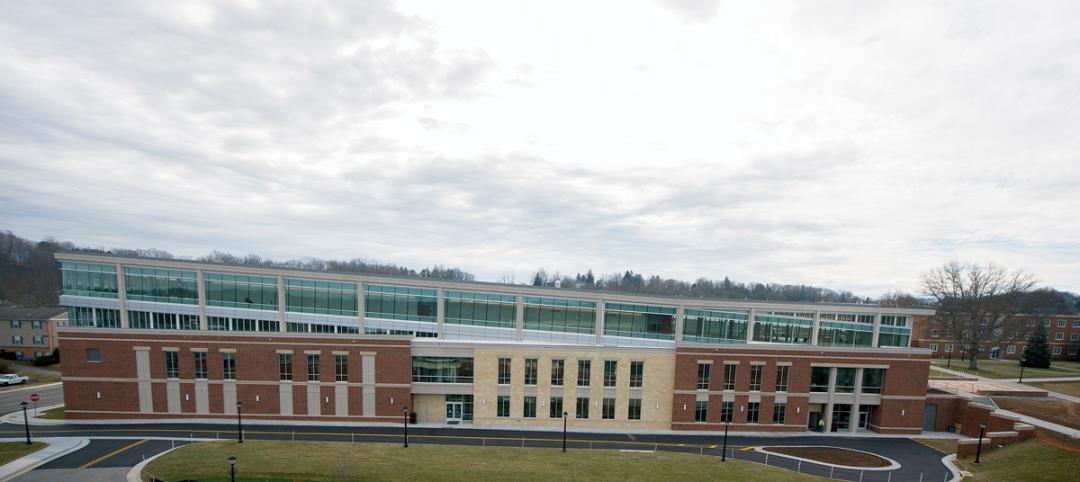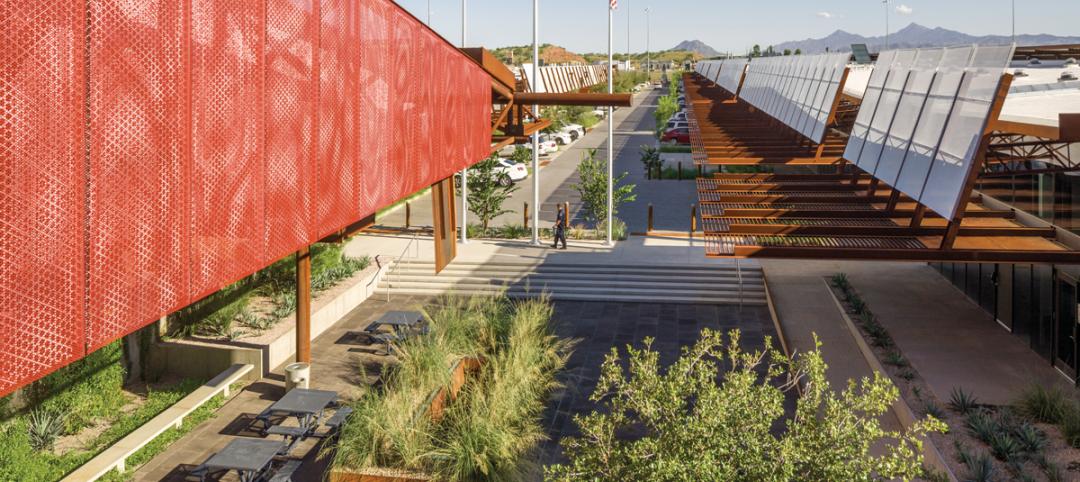The Pencil Building. That’s what passersby already are calling 150 North Riverside, the recently opened 54-story office building along the river in downtown Chicago.
No wonder. Viewed from the north or south, its silhouette resembles a giant stylus stabbed into a tight urban plot. That the structure can balance such height and mass on a pinpoint, 39-foot-wide base defies the imagination.
That 150 North Riverside managed to get built at all, despite technical constraints that scared off lesser mortals for nearly a century, is testament to the gumption of the developer, Riverside Investment & Development, and its Building Team, led by Clark Construction Group, architect Goettsch Partners, and structural engineer Magnusson Klemencic Associates (MKA).
The judges for the Building Team Awards were so impressed with the team’s determination to beat the odds that they unanimously honored 150 North Riverside with this year’s only Platinum Award.
Let’s take a look at what made this project so outstanding, starting with the site itself.
 The gigantic crane worked from a barge in the river. Photo: Andrew Bruah.
The gigantic crane worked from a barge in the river. Photo: Andrew Bruah.
NOT MUCH ROOM TO WORK IN
Five and a half years ago, after retiring as president of the John Buck Company, John O’Donnell, CEO of the then newly formed Riverside Investment & Development, acquired this two-acre parcel. The site, which O’Donnell had been eyeing for years, was flanked on the east by the Chicago River and on the west by seven active Amtrak rail tracks that consumed two-thirds of the acreage. That left a sliver 85 feet wide to build on. But not so fast! The city snatched a 30-foot slice to add another leg to the ever-lengthening Chicago Riverwalk, and O’Donnell mandated a 45-foot minimum lease span. What remained was a 40-foot-wide swath to accommodate a 6,318-sf base.
'We had a convergence of technical expertise that made the going-in risk more palatable.'
— Tony Scacco, Riverside Investment & Development
To gain elbowroom in which to work, the team proposed building a 1½-acre “bridge,” or deck, over the tracks. Ordinarily, belled caissons would have provided sufficient structural support for such a deck. But general contractor Clark Construction knew from its work on a nearby job that digging belled caissons can produce a lot of messy spoils that must be removed; they also require a big rig that takes time to demobilize. Since the pile driving could only be done from 1:00 to 5:00 a.m. to avoid clashing with Amtrak service, belled caissons were ruled out as a structural option.
MKA and geotechnical consultant GEI redesigned the foundations to a 9½-inch-diameter “micropile” system. This allowed Clark Construction to use a smaller rig that produced no spoils and could be maneuvered in and out of the rail yard quickly. But they also knew they had to limit the total number of piles, which meant the piles had to be as strong as possible. “We started with 400-kip micropiles, but GEI said the fewer times we had to dig, the better, so we kept going up in strength,” said MKA’s Robert Chmielowski, PE, SE.
In the course of about four months, Clark Construction sank over a hundred 600-kip micropiles—the highest-capacity piles ever installed in Chicago—between the tracks. “In terms of strength, 600-kip is off the charts,” said Chmielowski. For the tower foundation, MKA designed 16 fully reinforced caissons, each 10 feet in diameter, which were drilled six feet into bedrock. The team also pre-planned the foundation reinforcement design so that a floor could be added to the building midway through construction at the developer’s request.
The street-level bridge enabled Clark Construction to bring in upgraded utility service and to drive heavy equipment onto the site, which sped up the work. As for Amtrak service, “We had zero interruptions,” said Clark Construction’s Project Executive, Chris Phares, PE.
That took care of the Amtrak portion of the project. Dealing with the riverside edge of the site became a whole new exercise in problem solving.
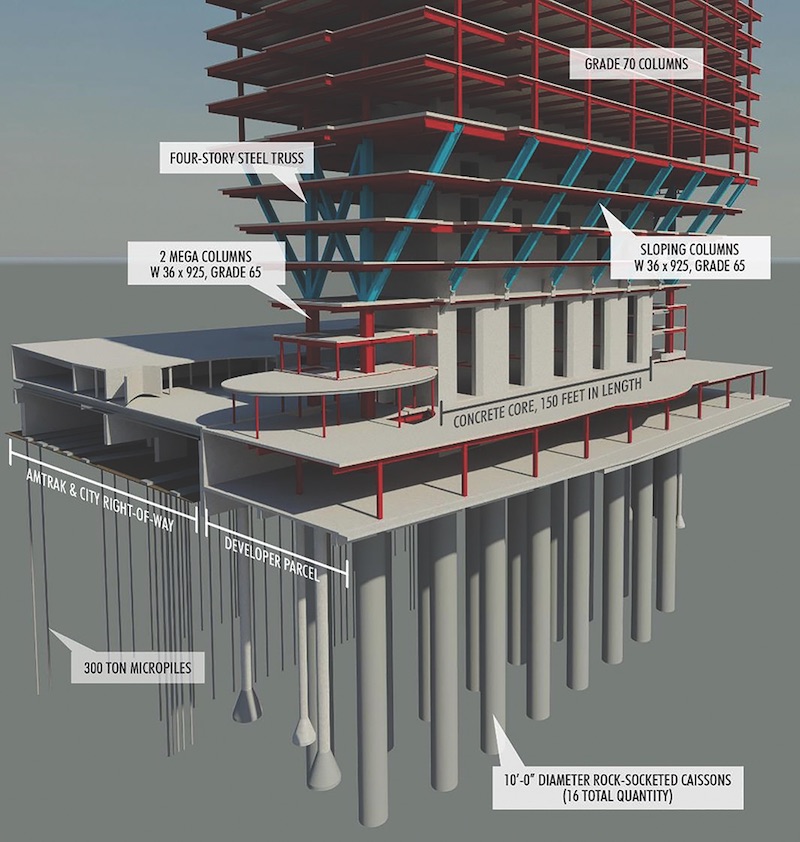 An elaborate micropile, caisson, and steel framework supports the tower. Magnusson Klemencic Associates.
An elaborate micropile, caisson, and steel framework supports the tower. Magnusson Klemencic Associates.
BUILDING ON EARNED KNOWLEDGE
Both Goettsch Partners and MKA had designed buildings that flared up from a narrow pedestal: Goettsch, in its design for Sowwah Square, Abu Dhabi; MKA, in its work on Rainier Tower, Seattle. In consultation with Clark Construction and GEI, they put this experience to work to create the sloping four-story steel trusses that support the 28,000-sf floor plates in the tower.
Once again, space was at a premium. Amtrak insisted that the erector’s crane had to be capable of hoisting 150% of the load—130,000 pounds of precast concrete bridge girders at a time—at a distance of 225 feet from center. There was no way a crane of that size could maneuver in the limited space available.
So the Building Team looked eastward for inspiration. “We decided to view the river not as a liability, but as an asset,” said Phares. “We said, Let’s put the crane on the river, and let’s make it the biggest crane possible.”
That’s what they did. Clark Construction tied 31 Poseidon barges together to form a floating platform. On it they mounted a two-million-pound Manitowoc 888 Ringer crane capable of lifting 1.3 million pounds at a time.
“We pieced together the biggest pieces that could be driven over the road, 60,000 pounds each, and put them together on site like an Erector Set, sometimes into quarter-million-pound assemblies,” said Phares. Using the gigantic Ringer, the erector, Chicago Steel Construction, was easily able to lift the huge trusses into position. “We drew particularly large crowds on the street and on the bridges when we did that,” said Phares.
‘the Riverwalk we created has become one of the most heavily traveled areas of the city. ’
— Chris Phares, Clark Construction Group
All this river-related activity required cooperation from the city, the Coast Guard, the Army Corps of Engineers, and the Metropolitan Water Reclamation District.
“Without that level of cooperation, we’d be looking at a big hole here,” said Erik Harris, AIA, CDT, Associate Principal, Goettsch Partners.
The team addressed the structure’s ability to resist wind acceleration and sway at higher levels—crucial to occupant comfort, said Chmielowski. They specified high-strength, high-stiffness concrete to strengthen and stiffen the structure’s core.
The Building Team also designed 12 water-filled tanks in groups of three on the roof to serve as a tuned liquid-sloshing damper. Once the building was complete, MKA monitored the dynamics of the as-built structure to determine the most effective height of the water, which turned out to be three feet, five inches, not four feet as originally estimated. “Now the tanks are really in tune with how the building behaves in the wind,” said Chmielowski.
Overall, the innovations the Building Team introduced, such as using bolted connections rather than welded ones in the steel members, trimmed 60,000 hours in labor and $3 million in costs, according to Clark Construction.

Precertified LEED Gold (Core & Shell), 150 North Riverside was also the first trophy property in Chicago to be certified Wired Platinum for excellence in technology infrastructure. The Class A+, 1.2 million-sf structure was 85% preleased at opening. Investment banker William Blair & Co., Hyatt Corporation, and Navigant are among the gold-star tenants.
‘Minimizing the number of piles we had to dig was a huge win.’
— Robert Chmielowski, MKA
“We don’t build monuments to ourselves,” said Riverside Investment & Development’s Executive Vice President, Anthony Scacco. “We build buildings that address the business needs of our tenants, specifically floor-plate efficiency, amenities, technology, and building infrastructure.”
It would seem that, in more ways than one, 150 North Riverside has really penciled out.
Building Team – Submitting firm, general contractor Clark Construction Group–Chicago Developer Riverside Investment & Development Co. Architect Goettsch Partners Structural engineer Magnusson Klemencic Associates MEP engineer Cosentini Associates Geophysical consultant GEI Wind studies RWDI Landscape architect Wolff Landscape Architecture
General Information – Size 1.2 million sf Cost $270 million Construction time September 2014 to January 2017 Delivery method CM at risk
Related Stories
Architects | Jan 18, 2016
EHDD’s Monterey Bay Aquarium wins AIA Twenty-five Year Award
The aquarium set new technical standards for the building type, which still influence today, such as the flow-through seawater-based heat pump system, naturalistic exhibitions, and corrosion protection.
Building Team Awards | Apr 10, 2015
14 projects that push AEC teaming to the limits
From Lean construction to tri-party IPD to advanced BIM/VDC coordination, these 14 Building Teams demonstrate the power of collaboration in delivering award-winning buildings. These are the 2015 Building Team Award winners.
Building Team Awards | Apr 10, 2015
Prefab saves the day for Denver hospital
Mortenson Construction and its partners completed the 831,000-sf, $623 million Saint Joseph Hospital well before the January 1, 2015, deadline, thanks largely to their extensive use of offsite prefabrication.
Building Team Awards | Apr 10, 2015
Anaheim’s soaring intermodal hub
Anaheim's Regional Transportations Intermodal Center is the largest ETFE project in North America.
Building Team Awards | Apr 10, 2015
Virtual collaboration helps complete a hospital in 24 months
PinnacleHealth needed a new hospital STAT! This team delivered it in two years, start to finish.
Building Team Awards | Apr 10, 2015
New arts venue reinvigorates Virginia Tech's campus
The STV-led Building Team creates a world-class performance and arts venue with learning and entrepreneurial dimensions.
Building Team Awards | Apr 9, 2015
Multifaced fitness center becomes campus landmark
A sloped running track and open-concept design put this Building Team to the test.
Building Team Awards | Apr 9, 2015
Nation's first LEED-certified bus depot
A bus garage in Harlem shows that even the most mundane of facilities can strut its environmentally sensitive stuff.
Building Team Awards | Apr 9, 2015
Setting the bar for port-of-entry design
Whenever you eat a tomato from Mexico, there’s a one-in-three chance it came through this LEED Gold gateway.
Building Team Awards | Apr 9, 2015
Big D’s billion-dollar baby: New Parkland Hospital Tops the Chart | BD+C
Dallas’s new $1.27 billion public hospital preserves an important civic anchor, Texas-style.


